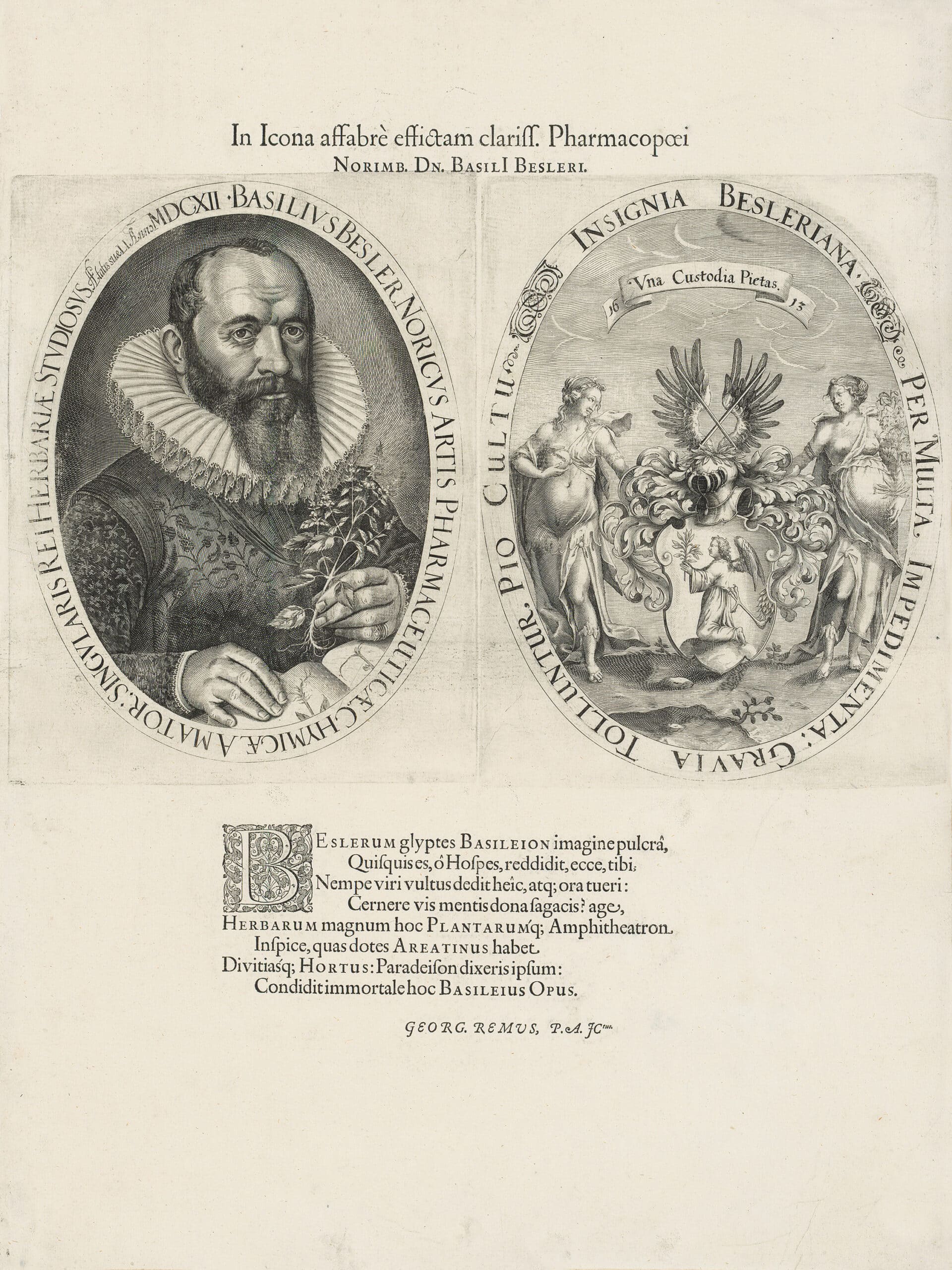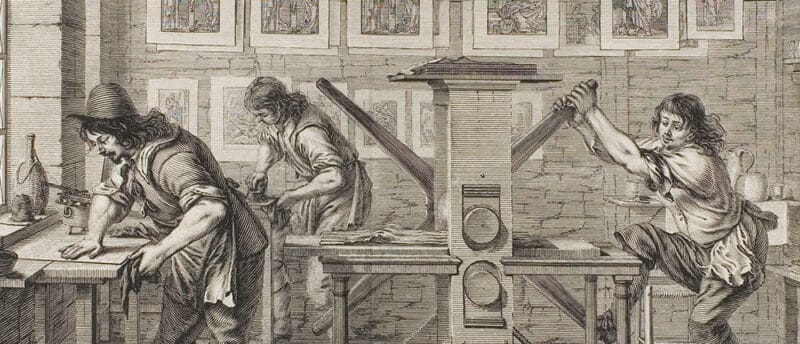Botanical Art, Information
How to Distinguish Between the Various Editions of Besler’s ‘Garden of Eichstätt’
Initially issued in 1613, Basilius Besler’s magnificent florilegium Hortus Eystettensis or Garden of Eichstätt was a monumental achievement in botanical art and enjoyed such success that it was republished several times. This guide will help you distinguish between the different editions of Hortus Eystettensis by examining the distinguishing characteristics, paper types, and material qualities of the Deluxe, 1st, 2nd, and 3rd editions.
Table of Contents
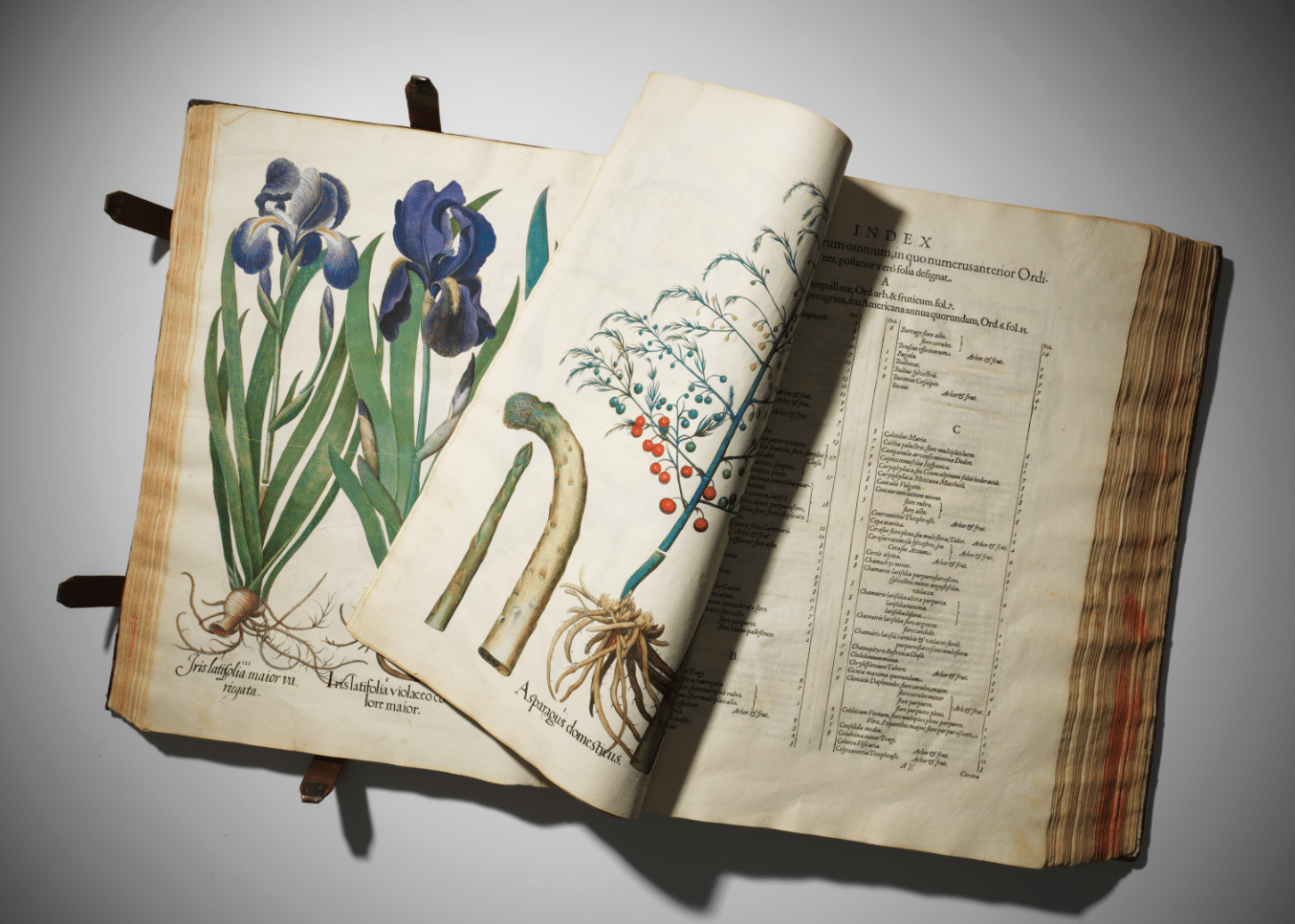
Deluxe Edition of Basilius Besler’s Hortus Eystettensis
Sold for $ 2,481,657.75 at Christies in 2016
History of the Folio
First published in 1613, Besler’s Hortus Eystettensis is the oldest of all the great botanical folios and the first visual compendium to represent the contents of a single garden. Capturing over 1,000 plant varieties on 367 exquisitely engraved plates, the folio acts as a monument to the beauty, diversity, and ephemerality of the Garden of Eichstätt. With a plate for each day of the Leap Year, plus one, the flowers were organized in accordance with the four seasons and issues alongside a descriptive text identifying each plant species.
The project was initiated by the garden’s owner, Johann Konrad von Gemmingen, the Prince Bishop of Eichstätt, who enlisted Nuremberg apothecary Basilius Besler to immortalize his extensive cultivations. Acting as the orchestrator, Besler coordinated the production of the imagery and text, compiling it into what would become the largest, most expensive book of the 17th century (Carroll 2009, 391).
Common Material Properties Found Throughout the Different Editions
Despite their distinguishing features, there are a number of fundamental likenesses between the various edition of Hortus Eystettensis. To begin with, all editions of Hortus were printed from the same copper plates, with few exceptions and minor revisions, on royal-sized sheets of laid paper measuring approximately 22” x 18”, the largest paper available at that time. Identifiable by its subtle grid-like pattern of horizontal and vertical lines, laid paper was the industry standard in Europe until the mid-18th century. While the paper stocks and manufacturers differ between each edition, all were printed on laid paper.
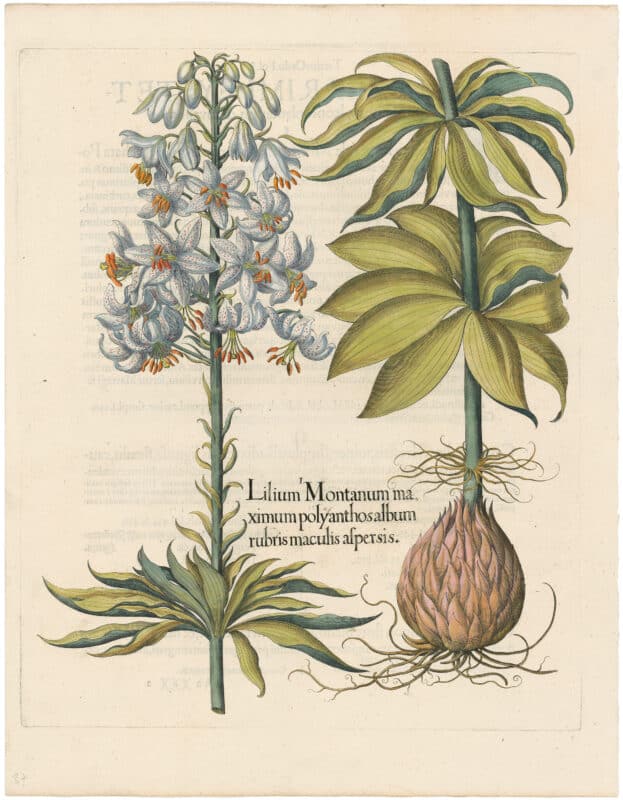
Besler 1st Ed. Pl. 183, Spotted White Martagon Lily
Caused by the pressure of the engraved metal plate passing through the rolling press, the platemark is visible as a rectangular depression around the printed image area.
view productAdditionally, all original untrimmed engravings from this folio have a platemark regardless of the edition. Detectable in the sheet margins outside the engraved image area, the platemark is a slight rectangular depression in the paper caused by the pressure of the engraved copper plate passing through the rolling press. This physical characteristic is common to all intaglio prints and can be helpful in determining the manner through which a print was produced.
Lastly, prints from all editions of Besler’s Hortus Eystettensis exist in both colored and colored forms today as some were illuminated at the time of production and others subsequently by the purchaser as was common in the print trade at that time. Moreover, while a number of the folios remain intact today, many were disbound and the individual plates were sold separately.
1st Edition / Trade Issue
After 16 years in the making, Hortus Eystettensis was issued in 1613 in two forms: the Deluxe edition and the 1st edition which is also called the common or trade issue. The 1st edition plates were printed in black ink on fine, white laid paper with letterpress printed text on the verso of each sheet denoting the botanical details of the following image. The paper used for the 1st edition is unwatermarked and has +/- 32 mm between the chain lines.
Intended for the book trade, most 1st edition copies were left uncolored upon issue and sold for 35 – 48 florins. Catering to the professional market, the folio was far less expensive than its Deluxe edition counterpart and was meant to serve as a reference guide for botanists, horticulturists, physicians, and apothecaries.

Laid paper
Laid paper retains the grid-like pattern and texture of the paper mold with strong chain lines running vertically and more plentiful laid lines running horizontally. All original Besler editions are printed on laid paper.
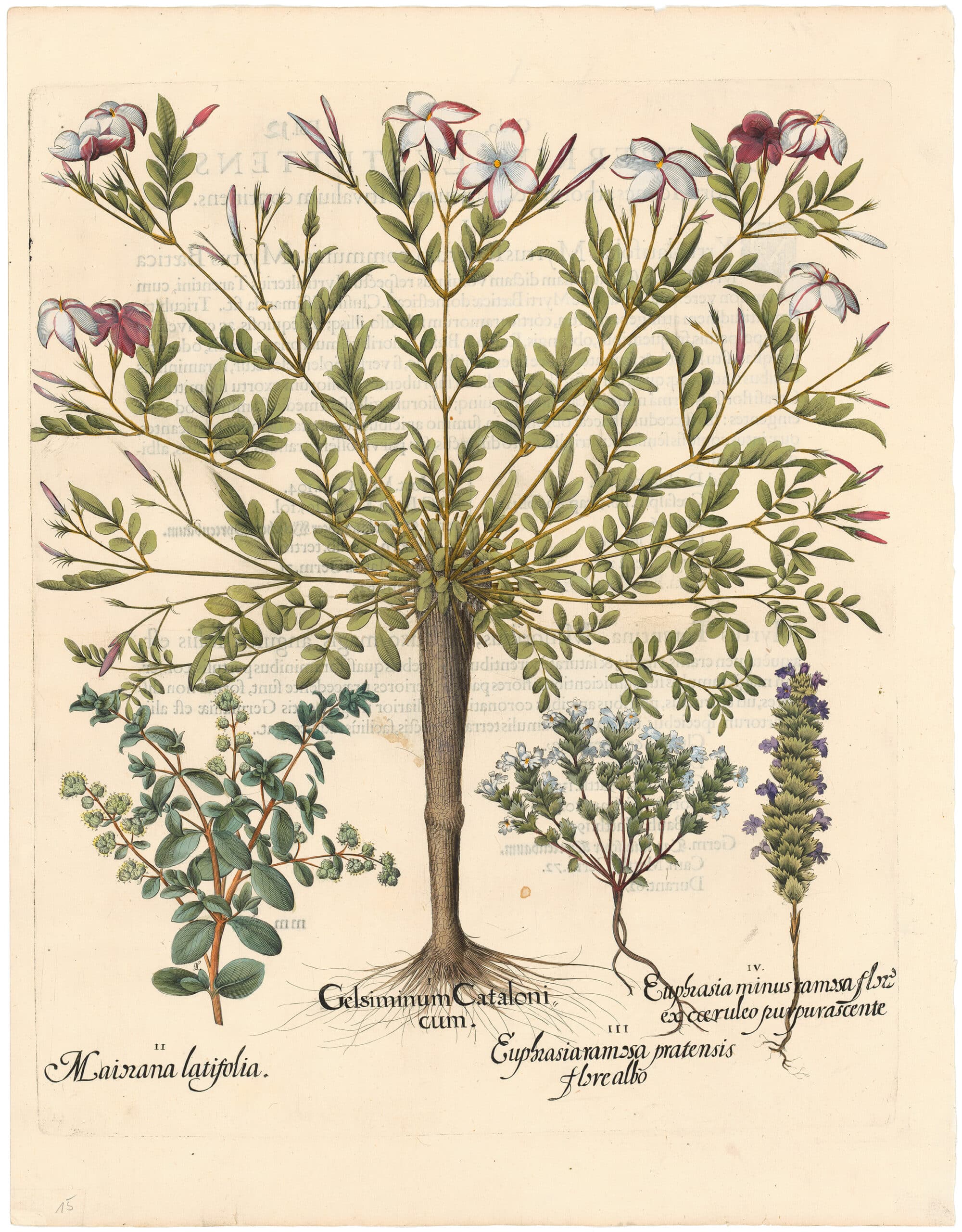
Recto of Besler’s 1st Edition Pl. 147, Sweet Majoram; Spanish Jasmine; Eyebright
A faint outline of the descriptive text is visible through the sheet.
view product
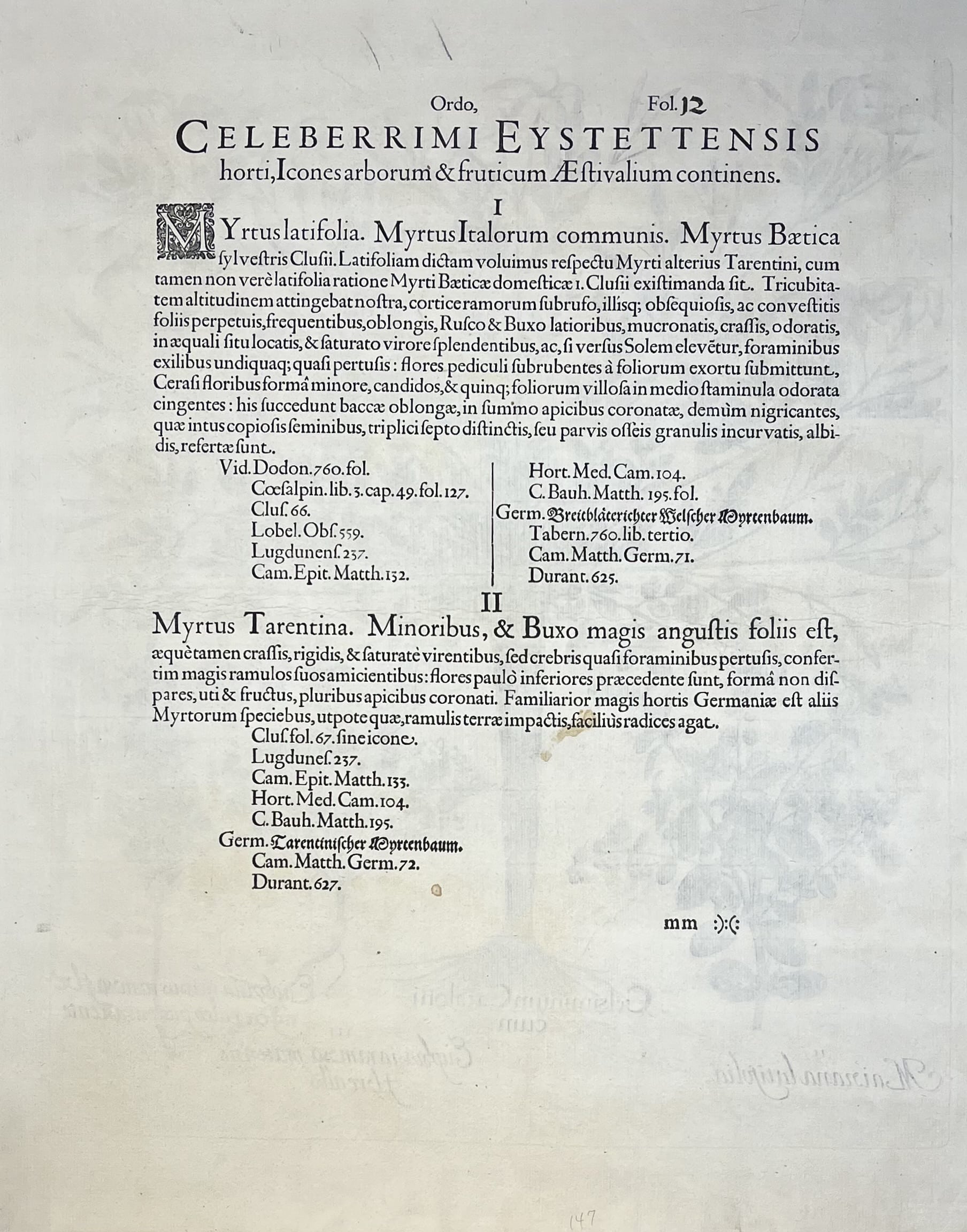
Verso of Besler’s 1st Edition Pl. 147, Sweet Majoram; Spanish Jasmine; Eyebright
The corresponding text for each plant was printed on the verso of Besler’s 1st Edition prints.
Deluxe Edition
Published alongside the 1st edition in 1613, the Deluxe edition was printed on either the same stock used for the 1st edition or a high-quality slightly creamy paper bearing a variation of the shield-with-grapes or “pomme de pin” watermark. Watermarks, often used to indicate the origin or quality of the paper, are formed during the papermaking process and can be revealed by shining a light through the sheet of paper. The watermarked laid paper used for the Deluxe edition has +/- 30 mm between the chain lines.
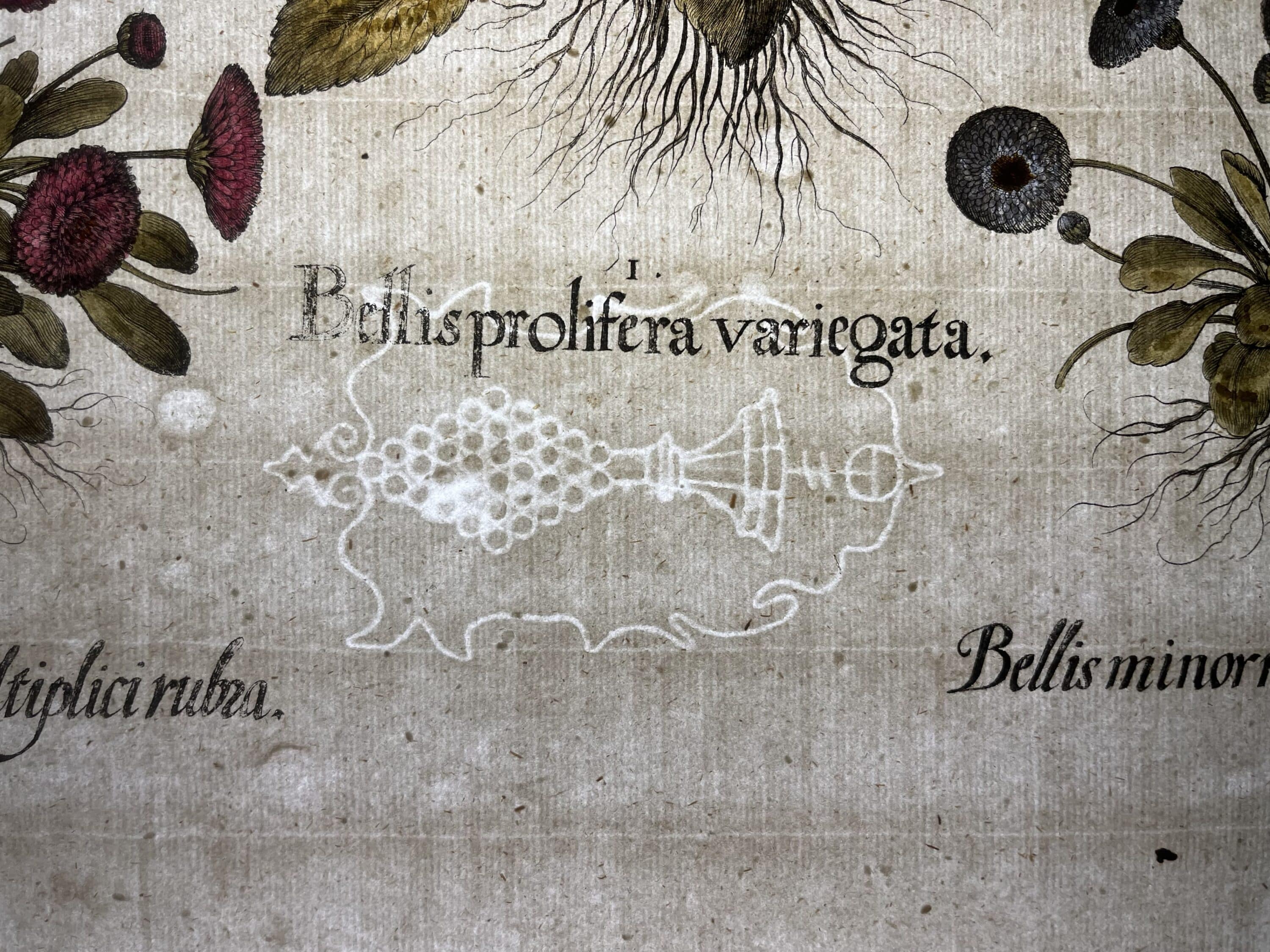
A watermark can be revealed by shining a light through the paper
Deluxe edition prints bear a variation of the “pomme de pin” or pinecone watermark. This watermark is sometimes described by scholars as grapes in a shield.
Unlike the 1st edition, the Deluxe edition has no letterpress text on the verso of the prints. Rather, the corresponding text was printed on separate sheets and interleafed between the plates so that the images could be colored without the paint bleeding through the sheet and obscuring the text. In some instances, the text was omitted altogether which bespeaks the Deluxe edition’s value as a visual work of art rather than a botanical index or reference book. Unlike the 1st edition, which was intended for the book market and would have required the corresponding text to serve the practical needs of horticulturists and botanists, the Deluxe edition was crafted for wealthy collectors and noble benefactors.
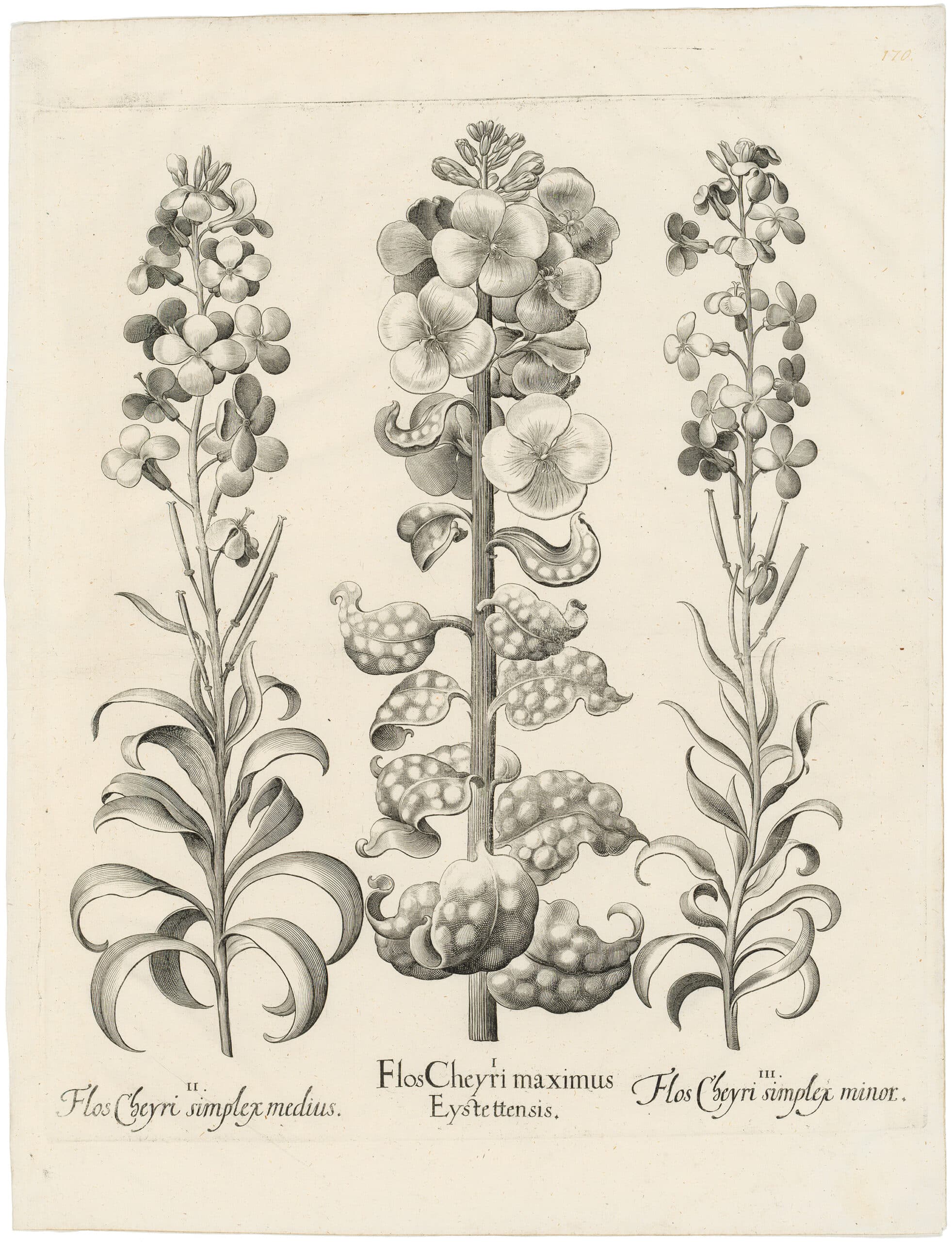
Besler Deluxe Ed. Pl. 170, Mauve columbine, Double-flowered purple columbine, et al
Uncolored engraving on laid paper
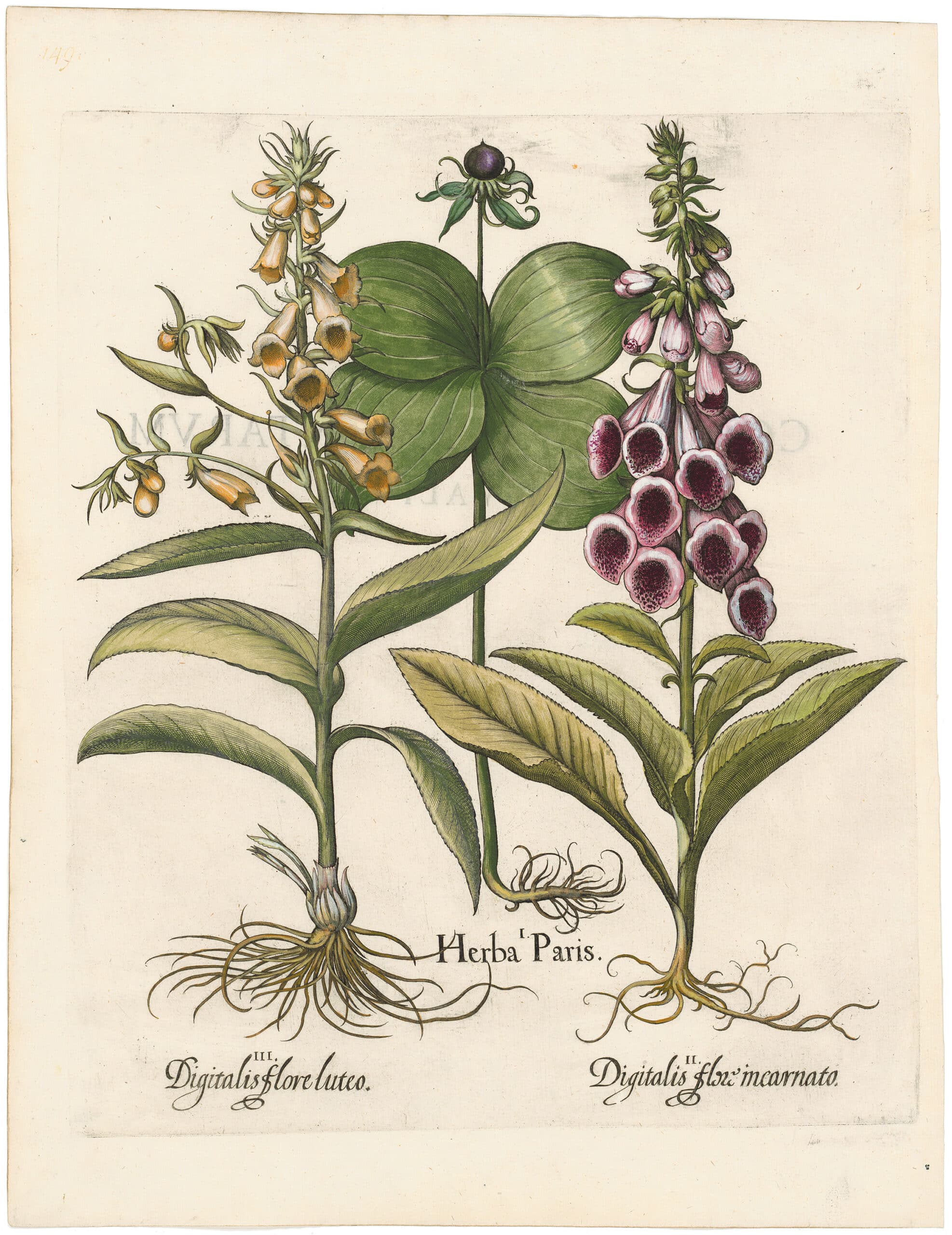
Besler Deluxe Ed. Pl. 149, Herb paris, Common pink foxglove, Yellow foxglove
Hand-colored engraving on laid paper
Issued in both colored and uncolored forms, the Deluxe edition sold for as much as 500 florins, the price of a small house. As was common at the time, many buyers elected to have the book colored or bound in unique ways after purchase.
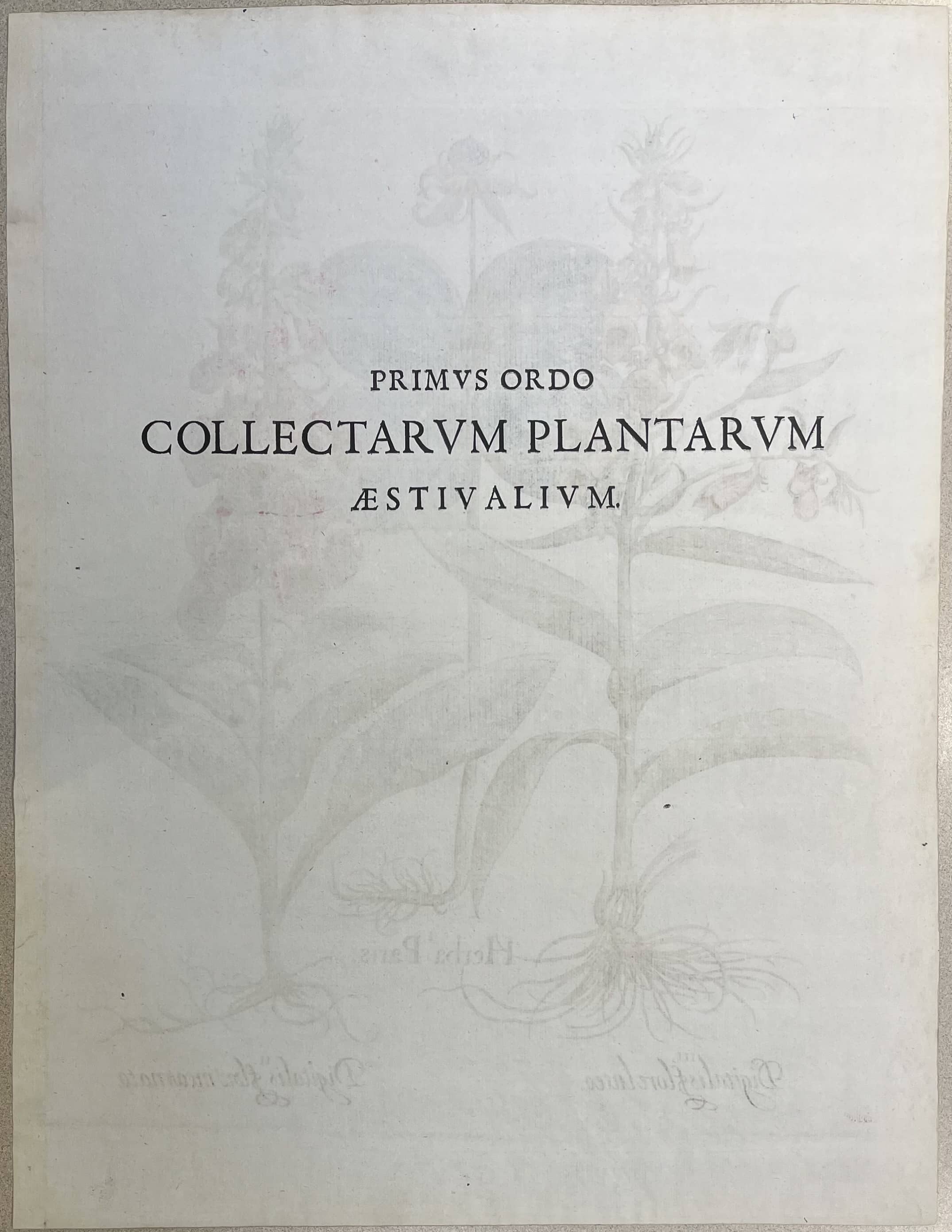
Half-title on verso of Deluxe edition print: “the first order of collected summer plants”
Not to be confused with the descriptive text on the verso of 1st edition prints, half-title text can be found on the verso of several Deluxe edition prints indicating the transition from one season to the next
While the Deluxe edition prints do not have the corresponding text on the verso, a number of the prints do have half-titles printed on the verso. These half-titles demarcate the transition from one section or season of the book to the next but are not to be confused with the descriptive text found on the versos of 1st edition prints.
2nd Edition
Issued in 1646, the 2nd edition was printed on white laid paper with chain lines running 26-28 mm apart and no text present on the verso. Several different paper stocks were used for the 2nd edition printing with some containing a serpent or crown watermark, and others no watermark at all (Barker 1994, 20). Several copies were colored at the time of production or soon thereafter while others remain black and white.

Crown watermark
Besler’s 2nd edition was printed on several different paper stocks some of which contain a serpent or crown watermark.

A greater degree of plate tone can be found on Besler’s 2nd and 3rd edition prints
Plate tone refers to the hazy areas on the sheet that are caused by residual ink on the surface of the copper printing plate.
Additionally, the engraved linework of 2nd edition prints tends to be less crisp than that of 1st and Deluxe edition prints as the copper plates had at this point endured several hundred runs through the press. As a result, the printers, in an attempt to retain more ink in the increasingly shallow engraved grooves, wiped the plates down with less vigor. Consequently, hazy areas of residual ink, called plate tone, are sometimes present in the blank areas of the print.
3rd Edition / Centenary Issue
Initiated in 1712 but delayed in publication until 1750, the 3rd edition was issued in celebration of the centennial of Hortus Eystettensis. Printed in black and white on laid paper, the 3rd edition is recognizable for its thicker, slightly grainy paper stock. Much like the 1st edition, the descriptive text was printed on the verso of the 3rd edition prints and no watermark is present in the paper. Similar to the 2nd edition, 3rd edition prints often exhibit a greater degree of plate tone and softer linework than the previous editions due to the compounding wear of the copper plates.
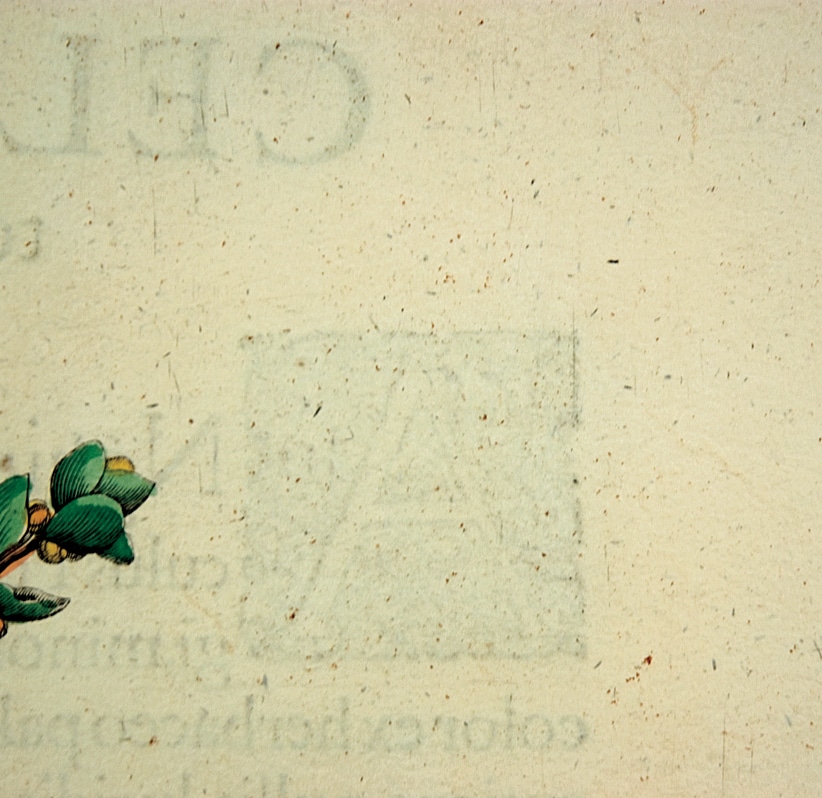
Detail of 3rd edition print
Besler’s 3rd edition was printed on thick, grainy paper stock
Conclusion
While a casual glance might discern no difference between the various edition of Hortus Eystettensis, an informed eye will be able to recognize the various attributes unique to each issue. As a physical piece of history, each print carries within its fibers the story of its origin and manufacture. For decades scholars believed that the original copper plates for Hortus Eystettensis had been destroyed or melted down. However, in 1994, 329 of the original 367 copper plates were rediscovered in Vienna’s Albertina Museum collection (Carroll 2009, 400). Thus the material history of the folio continues to unfold.
Check out the links below to learn more about printmaking and Basilius Besler’s florilegium.
References
Barker, Nicolas. 1994. Hortus Eystettensis, The Bishop’s Garden and Besler’s Magnificent Book. New York: Harry N. Abrams.
Carroll, Angus. 2009. “The ‘Hortus Eystettensis’: How Paper Type Can Help Decipher Printing History.” The Papers of the Bibliographical Society of America 103, no. 3: 391–400. http://www.jstor.org/stable/24293820.
Dressendorfer, Werner and Klaus Walter Littger. 2001. The Garden at Eichstatt: Baslilius Besler’s Book of Plants. Köln: Taschen.


